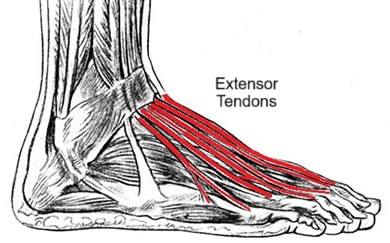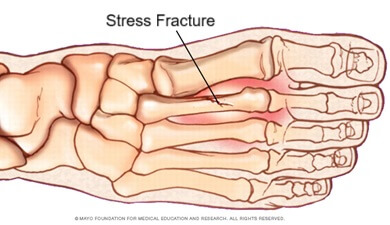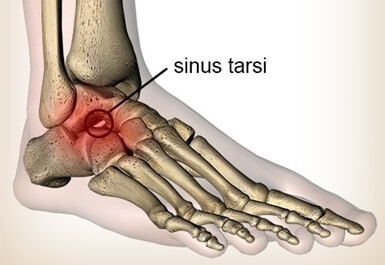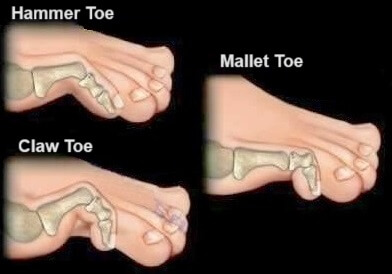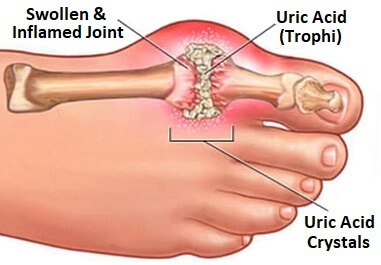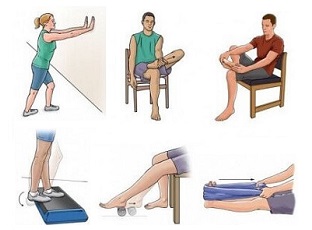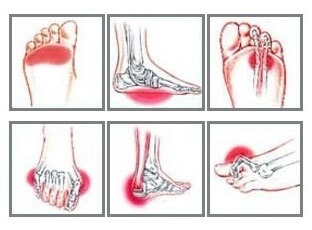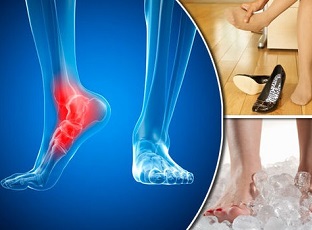- Home
- Diagnosis Guide
- Top Of Foot Pain
Pain On Top of Foot
Written By: Chloe Wilson BSc(Hons) Physiotherapy
Reviewed By: FPE Medical Review Board

Pain on top of the foot is a common problem.
Every step we take places a force 1.5x body weight through our feet so it's no wonder our feet get sore!
Most cases of pain on top of the foot are due to either an injury, overuse, wear and tear or even ill-fitting footwear. Pain may be due to a problem in the bones, soft tissues or various medical conditions. There may even be a top of foot lump.
We are going to look at the common causes of pain on top of the foot, how they present and the best ways to treat them.
Causes Of Top Of Foot Pain
The most common causes of pain in the top of the foot are due to damage to the:
- Bones: e.g. stress fractures, sinus tarsi syndrome & tarsal coalition
- Soft Tissues: e.g. extensor tendonitis or tibialis anterior tendonitis
- Skin: e.g.athlete's foot
- Medical Conditions: e.g. gout, ganglions or nerve damage
Here we will look at the most common causes of pain on top of foot and how to tell which one is causing your foot problem, then we'll go on to look at how to treat them.
1. Extensor Tendonitis
Extensor tendonitis is the most common cause of pain on top of foot that comes on gradually.
With extensor tendonitis there is inflammation of the tendons that run across the top of the foot and contract to lift the toes.
Extensor tendonitis usually causes a gradual increase in pain, swelling & tenderness over the top of foot and there is often discomfort when wearing shoes due to pressure on the tendons
Tight shoes, flat feet, prolonged standing/walking, muscle tightness and off-road running are common causes of extensor tendonitis.
You can find out all about this common cause of pain on top of foot, including the causes, symptoms and treatment options in the Extensor Tendonitis section.
2. Stress Fractures
Stress fractures are a common cause of pain on top of the foot caused by a small break in one of the foot bones e.g. metatarsal fracture
Stress fractures cause moderate to severe pain, swelling and tenderness over the fracture site.
Most stress fractures are the result of repetitive overloading e.g. kicking, running, jumping or suddenly increasing training levels.
You can find out all about the different causes, symptoms and treatment options in the Foot Stress Fractures section.
2. Sinus Tarsi Syndrome
Sinus tarsi syndrome is a common cause of ongoing pain on top of foot after an ankle sprain.
With sinus tarsi syndrome there is inflammation of the small, bony channel between the heel & ankle.
Common symptoms include ankle stiffness, instability, pain on outer side of the top of the foot when walking or standing.
Sinus tarsi syndrome most often develops after an ankle sprain but may also be due to prolonged instability and altered foot biomechanics
Find out all about the common causes, symptoms, diagnosis and treatment options in the Sinus Tarsi Syndrome section.
3. Toe Deformities
There are three common toe deformities that cause top of foot pain by altering the positions of the small bones, hammer toe, mallet toe and claw toe.
The most common symptoms are abnormal curling of one or more toes which may or may not be accompanied by stiffness and pain.
Toe deformities often develop from wearing tight, pointed shoes but may also be caused by a toe injury, problems in nerves or blood vessels or arthritis
Find out all about these common toe deformities, how to tell which one you have and how to treatment them Hammer, Mallet, Claw Toes section.
5. Tibialis Anterior Tendonitis
Another possible cause of top of foot pain is tibilais anterior tendonitis. This is where there is inflammation of the tendon at the front of the ankle that lifts up the foot.
Tibialis anterior tendonitis usually causes a gradual increase in pain on top of foot and at the front of ankle which often feels worse after resting.
Common causes incude overuse e.g. running, esp. off-road or downhill and muscle weakness & tightness.
You can find out all about the common causes, symptoms and treatment options in the Tibialis Anterior Tendonitis section.
6. Gout Foot
Gout foot is a type of inflammatory arthritis that causes crystals formation in joints e.g. big toe, due to high uric acid levels.
Gout foot causes a sudden onset of intense pain in the big toe and on top of the foot (typically at night), redness, heat and swelling in the foot.
You are more at risk of developing foot gout if you have a purine-rich diet (lots of red meat), have a family history of gout, are overweight or have diabetes.
Find out all about the causes and symptoms of gout and how to treat and prevent it in the Gout Foot section.
7. Athlete's Foot
One of the less common causes of pain on top of the foot is Athletes Foot, a fungal infection of the skin. Also known as tinea pedis it affects approximately 15% of the world's population.
Athlete's foot results in scaly, itchy, flaking skin, swelling and blistering which can cause pain on top of the foot.
It normally develops due to poor foot hygiene, excess moisture, humid conditions and is highly contagious.
You can find out all about the causes, symptoms and treatment options in the Tinea Pedis section.
8. Nerve Pain
Pain on top of the foot that is accompanied by altered sensation is often due to nerve damage in the foot, leg or lower back.
There may burning or shooting pain along the top of the foot, pins and needles, numbness and/or foot weakness where the nerve has become pinched or compressed.
Nerve injuries usually originate from swelling, injury, spinal deformity or disc bulge in the lower back. There is often no actual pain in the back itself, the symptoms may only be felt in the foot.
Find out all about the causes, symptoms, diagnosis and treatment options in the Nerve Pain In Foot section.
9. Ganglion Cyst
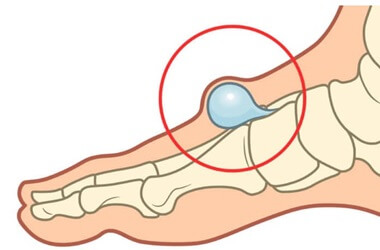
Pain on top of the foot that is accompanied by a lump is often due to a ganglion cyst.
Ganglion cysts are small lumps filled with jelly-like fluid often found near the foot joints & tendons.
They are small, pea-like nodules that can causes pain if the press on nearby structures in the foot, particularly nerves.
Often there is no obvious reason why ganglion cysts develop but they are more common after a foot injury or as we age.
Find out more about common causes of foot lumps and ganglion cysts in the Lump On Top Of Foot section.
10. Tarsal Coalition
Tarsal coalition is a rare cause of pain on top of the foot affecting only around 1% of the population.
With tarsal coalition, a bony bridge forms between two or more of the foot bones. This leads to stiffness, instability and foot pain, typically in early adolescence.
Tarsal coalition is a congenital condition (present since birth) and is often hereditary.
Find out all about the common causes, symptoms and treatment options in the Tarsal Coalition section.
11. Shin Splints
Pain at the top of the ankle and in the front of the shin is a common problem, particularly in runners. In most cases, it is due to Shin Splints, aka medial tibial stress syndrome.
Repetitive overuse of the shin muscles which help to move the foot causes irritation, inflammation and tenderness in the shin bone. Shin splints are particularly common in people who suddenly increase their activity level, be it frequency, duration or intensity.
Find out all about the common causes, symptoms and best treatment options in the Shin Splints section.
You can find out loads more about each of these conditions, including the best treatment options for each one, by using the links above.
Diagnosing Pain On Top Of Foot
Much of the time, pain on top of the foot will settle down, using simple home treatments, within a week. If the pain persists for longer, or is severe, you should see your doctor.
The doctor will ask you:
- when your top of foot pain started
- how it started
- if you have any other symptoms
- about any past foot or ankle injuries
- your normal activity levels
- what things make the pain better or worse
- if there is any pattern to your pain
Then, they will examine your foot for any signs of swelling or deformity. The will look at you walking and then look at the movement and strength in and around your foot.
If the doctor suspects a bony injury, you will be sent for an x-ray. They may also order blood tests or an MRI.
What's Causing My Top Of Foot Pain?
Pain on top of the foot is often accompanied by other symptoms which can help you to work out what is causing your top of foot pain:
- Mild-Moderate Pain On Top Of Foot (Gradual Onset): extensor tendonitis (top of foot), tibialis anterior tendonitis (front of ankle)
- Stiffness and Instability: sinus tarsi syndrome (after ankle sprain), tarsal coalition (early adolescence), hallux rigidus (big toe)
- Severe, Sudden Pain: stress fracture (day), gout (night)
- Top Worse after Rest: tendonitis
- Worse with Activity: stress fracture, sinus tarsi syndrome, tendonitis, shin splints
- Abnormal Toe Curling: hammer toe, mallet toe or claw toe
- Redness Big Toe: gout
- Lump On Top Of Foot: ganglion cyst, stress fracture, hallux rigidus
- Itchy, Flaking Skin: athlete's foot
- Pins and Needles or Numbness: nerve problem
Treating Pain On Top Of Foot
Treatment for pain on top of the foot will depend on what the underlying cause is. If it is a minor problem with minimal pain and swelling, you can usually treat your top of foot pain at home with a combination of:
- Rest: avoid aggravating activities for the first few days
- Ice: regularly applying ice packs helps to reduce pain and inflammation
- Medication: over-the-counter painkillers e.g. paracetamol or NSAID's e.g. ibuprofen can help to reduce pain and inflammation
- Elevation: when resting, prop your leg up so the foot is higher than your heart so gravity can help reduce swelling. Either use cushions, pillows or a special leg elevation cushion
- Compression Bandage: wearing Tubigrip helps to support the foot and ankle and reduce swelling
- Gentle Exercises: simple foot exercises such as pumping your feet up and down at the ankles helps to reduce swelling, improve circulation and reduce the risk of muscle weakness and tightness
If the foot pain is more severe, is getting worse, there is a lump on top of foot, significant swelling or you are unable to bear weight, you should see you doctor. They may then advise:
- Physical Therapy: may involve rehab, manual therapy, taping and electortherapy
- Orthotics: specially designed inserts help to correct abnormal foot position
- Acupuncture: can help reduce pain and inflammation
- Crutches: are a good way to rest the foot but still be able to get around
- Surgery: is not normally necessary for pain on top of foot unless it is something serious or the pain has failed to settle after a few months of treatment
You can find out loads more about how to reduce pain on top of the foot in the foot pain treatment section, or
- Extensor Tendonitis Treatment
- Stress Fracture Treatment
- Sinus Tarsi Treatment
- Toe Deformity Treatment
- Tibialis Anterior Tendonitis Treatment
- Gout Foot Treatment
- Athlete's Foot Treatment
- Foot Nerve Pain Treatment
- Ganglion Cyst Treatment
- Tarsal Coalition Treatment
- Shin Splints Treatment
What Else Can Help?
The most common causes of pain on top of foot are extensor tendonitis, stress fractures, overuse, injuries, bone problems or underlying medical conditions.
Here, we have looked at the most common causes of pain on top of foot. Any new incidence of pain should always be assessed by your doctor to ensure an accurate diagnosis. If you have any lumps or bumps on top of your foot, check out the top of foot lumps article.
To find out more about these common causes of pain on top of foot, choose the appropriate link above. Or, if you want some help working out what is causing your top of foot pain, visit the foot pain diagnosis section. If you have pain in another area of your foot, check out the following articles:
- Toe Pain
- Ball Of Foot Pain
- Bottom Of Foot Pain
- Pain On Outside Of Foot
- Pain On Inside Of Foot
- Heel Pain
- Foot Pain When Walking
Related Articles
References
- Pain In The Top Of The Foot. NHS UK
- Current And Future Advances In Practice: Mechanical Foot Pain. Rheumatology Advances In Practice
- Management Of Extensor Tendon Injuries. The Open Orthopaedics Journal
Page Last Updated: 23rd January, 2025
Next Review Due: 23rd January, 2027
